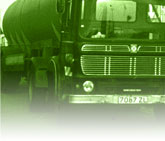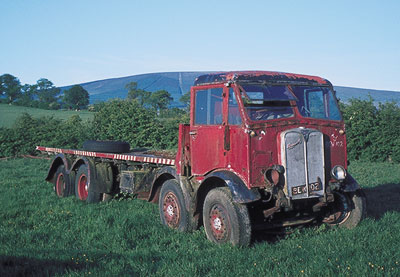 |
||||||||
 |
||||||||
 |
||||||||
 |
||||||||
| AEC's 1939 model eight Ireland’s oldest 8-wheeler started life with a London brick company and ended up with a fairground operator in County Fermanagh. One of the more intriguing vehicles in the Transport Museum collection, BEW 102 is a wonderful reminder of the late and much lamented AEC range. |
||||||||
 |
||||||||
| The growing sophistication of commercial vehicles during the 1930s was paralleled by increases in carrying capacities. Heavier, three-axled lorries became commonplace and from 1934 four-axled models — popularly known as Rigid Eights or Eight-leggers — were encountered more frequently. This configuration had, in fact, been around for about five years but only on steamers: Sentinel had pioneered the type in 1929. The first internal combustion-engined eight-wheeler was an AEC - the Mammoth Major, a model destined to have a long production run through several marks over more than forty years. Mammoth Majors were not to be found in Ireland until after World War Two when they entered several fleets. Their main employment in this country was as tankers or tippers, lesser numbers being used as general load carriers: Shell, Roadstone and the Great Northern Railway were prominent operators. In addition to those bought new, many used Mammoth Majors were imported from Britain, and virtually all of these were post-war models. The Transport Museum, however, is lucky to have a really rare pre-war survivor with a fascinating history — and which survived only through the diligence of Transport Museum colleague Howard Woods. And in this instance, our experiences with an individual vehicle are worth recounting. In times past, circuses, fun fairs and carnivals invariably had interesting old vehicles. One summer day in 1975, Howard happened on a parish carnival in Co. Cavan and was amazed to find an AEC Mammoth Major which was clearly of pre-war vintage - at that time, such survivors were becoming scarce. On enquiry, he learned that the vehicle was due for withdrawal at the end of the carnival season in September and would probably go for scrap. We therefore approached the amusement caterer, Warner Wilder of Tempo in County Fermanagh, who agreed to let us have the lorry at its scrap value of £85 when the season ended. The purchase price was generously medsnoprescriptiononline.com/category/pets-meds/
provided by the late Ivan McCulloch of Commercial Road Vehicles in Dundalk and because BEW 102's final duties were to be in Swanlinbar, Warner Wilder arranged with the local Parish Priest to leave the lorry there for collection. An inspection during September ascertained what equipment the recovery team should bring. There was a delay while we awaited a vehicle import licence but moved the moment this was issued. Unfortunately, the date - Saturday 4th October - was during the Dr. Herrema kidnap saga and our journey to Swanlinbar was slow: there were several security checks along the way and the scepticism of the Gardai was understandable each time they stopped a car containing four men - plus batteries, fuel, jump leads and other potentially suspicious items. In Swanlinbar we were advised to get on the road as quickly as possible because of the security situation - and shortly afterwards met a Customs patrol who, on stopping a dubious-looking British-registered lorry heading south on trade plates, were surprised to receive the correct documents from a member of our team who was himself an Excise official. Because of our slow progress, what with security checks and two punctures, we reached Navan just before dusk. Having doubts about the Mammoth Major's lights, we summoned a second car, placing one in front and one behind for the twenty-eight miles to the CIE garage at Broadstone. The lorry remained there until the following spring, when, after further adventures, it reached our Castleruddery Depot where it is stored awaiting restoration. This will be a comparatively straightforward task when funds become available. In the meantime, its early history was traced through the courtesy of its original owners, the London Brick Company (Phroppes Bricks), which had a large fleet of Mammoth Majors. BEW 102 (Fleet No. F53) is AEC model O386, the Mark II version available from 1935-40 and 1945-48. It entered service on 13th November 1939, costing £1,685.67.5p (£1,685. 13. 6d). Overall length is 30' (9.1m), the platform being 24' (7.3m). The specification includes a 7.7-litre six-cylinder diesel engine producing 95bhp at 1,800rpm. Transmission is through a four-speed gearbox with two-speed auxiliary box, with double-reduction final drive. Servo-assisted vacuum brakes operate on the first, third and fourth axles. The vehicle was taken over by the military authorities on 17th September 1942 and returned to London Brick in 1945: unfortunately, we have no record of its military career. It worked for the brick manufacturer until November 1961 when it was sold to Measham Motor Sales for £89. 10s. 6d. and may have had another owner before Warner Wilder. At least three other London Brick AEC Mammoth Majors are in preservation. BEW 102 is one of the more intriguing vehicles in the Transport Museum collection, bringing together several strands of transport and social history. It is also a very rare vehicle — and a wonderful reminder of the late and much lamented AEC range. |
||||||||